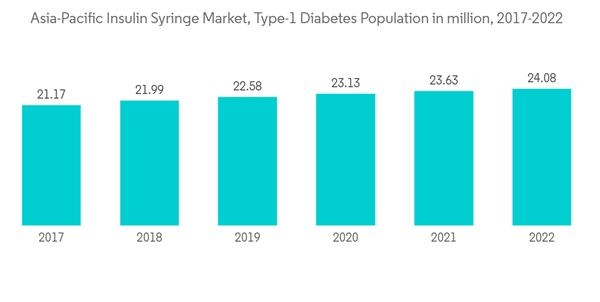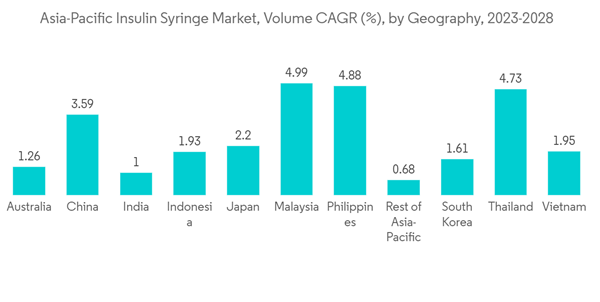India holds the highest market share in the Asia-Pacific Insulin Syringe Market and is expected to register a CAGR of more than 1.4% in the forecast period.
The COVID-19 pandemic positively impacted the Asia-Pacific Insulin Syringe Market growth. Patients with diabetes, infected with COVID-19 may experience elevated blood glucose, abnormal glucose variability, and diabetic complications. The prevalence of diabetes in people with COVID-19 caused a significant increase in severity and mortality of COVID-19 in people with either type 1 (T1DM) or type 2 diabetes mellitus (T2DM), especially in association with poor glycemic control. While new-onset hyperglycemia and new-onset diabetes (both T1DM and T2DM) have been increasingly recognized in the context of COVID-19 and have been associated with worse outcomes.
Patients with diabetes require many corrections throughout the day to maintain nominal blood glucose levels, such as administering additional insulin or ingesting additional carbohydrates by monitoring their blood glucose levels. The manufacturers of Insulin Syringes have taken care during COVID-19 to deliver insulin delivery devices to diabetes patients with the help of local governments.
Diabetes poses an emerging healthcare burden across the region. Comparing the population with and without diabetes, those with diabetes have a 300% increased risk of being hospitalized and thus incur more healthcare expenses compared to non-diabetic people. Furthermore, patients attempting to control their blood glucose levels tightly to prevent the long-term complications associated with fluctuations in blood glucose levels are at greater risk for overcorrection and the resultant hypoglycemia. Achieving nominal results can be very difficult without multiple daily injections of insulin or insulin pump therapy.
Owing to the aforementioned factors the studied market is anticipated to witness growth over the analysis period.
Asia-Pacific Insulin Syringe Market Trends
Rising diabetes prevalence
The diabetes population in the Asia-Pacific region is expected to rise by more than 1% over the forecast period.The Asia-Pacific region has witnessed an alarming increase in the prevalence of diabetes in recent years. In developing countries such as China and India, the rate of diabetes is at an all-time high, mainly due to lifestyle changes. According to the International Diabetes Federation, 90 million adults were living with diabetes in the IDF South-East Asia Region in 2021. This figure is estimated to increase to 152 million by 2045, and the 206 million adults living with diabetes in the IDF Western Pacific Region in 2021 are estimated to increase to 260 million by 2045.
Diabetes is associated with many health complications. Patients with diabetes require many corrections throughout the day for maintaining normal blood glucose levels, such as oral anti-diabetic medication, insulin administration, or the ingestion of additional carbohydrates by monitoring their blood glucose levels. Furthermore, patients attempting to control their blood glucose levels tightly to prevent the long-term complications associated with fluctuations in blood glucose levels are at greater risk for overcorrection and the resultant hypoglycemia. Achieving nominal results can be very difficult without multiple daily injections of insulin or insulin pump therapy. Moreover, the increasing adoption of insulin-delivery devices and the rising prevalence of diabetes are driving market growth. Leading manufacturers are focusing on technological innovations and the development of advanced products to gain a substantial share of the market.
Therefore, owing to the aforementioned factors, the studied market is anticipated to witness growth over the analysis period.
India is expected to dominate the Asia-Pacific Insulin Syringe Market over the forecast period
India holds the highest market share in the Asia-Pacific Diabetes Care Devices Market and is also expected to register a CAGR of more than 0.8% over the forecast period.Nearly 10% of India's population is likely to be affected by diabetes over the forecast period. Obesity, especially central obesity, increased visceral fat due to physical inactivity, and consumption of high-calorie, high-fat, and high-sugar diets are the major contributing factors to diabetes in Indians. The most prominent work culture perpetuated in the country, which includes sitting for hours in one position and eating fast food with little or no physical activity, is a significant contributor to diabetes in the working-age group, causing this rapid increase in diabetes cases in India.
According to the Ministry of Health and Family Welfare of the Government of India, in 2021, out of all deaths in India, 60% were related to non-communicable diseases like diabetes, cardiovascular diseases, cancer, chronic respiratory diseases, etc. To prevent and control major NCDs, the National Program for Prevention and Control of Cancer, Diabetes, Cardiovascular Diseases, and Stroke (NPCDCS) has been launched. This program includes medical education, health awareness in schools, and urban planning for diabetes.
Such factors have contributed to the rise in the adoption of these products in the Indian market.
Asia-Pacific Insulin Syringe Industry Overview
The Asia-Pacific insulin syringe market is fragmented and has been driven by constant innovations by manufacturers, such as Becton Dickinson, Terumo Corporation, and HMD Healthcare Ltd. etc. which resort to inorganic market strategies, such as mergers and acquisitions, to establish market dominance, while also adhering to organic growth strategies, which is evident from the R&D spending of these companies.Additional Benefits:
- The market estimate (ME) sheet in Excel format
- 3 months of analyst support
This product will be delivered within 2 business days.
Table of Contents
Companies Mentioned (Partial List)
A selection of companies mentioned in this report includes, but is not limited to:
- Becton Dickinson
- Terumo Corporation
- Nipro Corporation
- HMD Healthcare Ltd.
- Cardinal Health
Methodology

LOADING...










